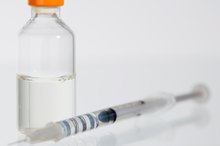What Are the Treatments for High Testosterone in Females?
Testosterone — the primary male hormone, or androgen — is produced by women as well as men. In women, the adrenal glands and ovaries produce androgens. High testosterone levels in women cause excess facial and body hair, acne, irregular or absent menstrual periods and male pattern hair loss of the head.
The most common cause of increased androgen production in women is polycystic ovary syndrome (PCOS), a condition in which the ovaries produce too much androgen 1. This disorder affects 5 to 10 percent of women, Merck Manual reports.
Congenital adrenal hyperplasia — a disorder in which the adrenal glands produce too much androgen — and some ovarian tumors are among other causes of elevated testosterone levels in women. Treatments include prescription medications and lifestyle changes.
Oral Contraceptives
Oral contraceptives, commonly called birth control pills, can lower testosterone levels. They reduce acne and excess facial and body hair and help prevent male pattern hair loss in women. Oral contraceptives are useful for regulating periods but they are obviously not appropriate for women who want to become pregnant. Women with previous blood clots should not take oral contraceptives.
- Oral contraceptives, commonly called birth control pills, can lower testosterone levels.
- Oral contraceptives are useful for regulating periods but they are obviously not appropriate for women who want to become pregnant.
Metformin
Herbal Testosterone Blocker
Learn More
Metformin, a medication most commonly used to lower blood sugar levels in people with Type 2 diabetes, reduces testosterone levels in women. It may also help women lose weight, which can further lower androgen levels. Periods often become regular with metformin and the chances of having a baby may also improve, according to a systematic review of metformin use in women with PCOS published in "Cochrane Database of Systematic Reviews" in November 2017. Bloating, nausea, vomiting and diarrhea are some of the most common side effects of metformin. As metformin can lower sugar levels and also affect kidney and liver function, women taking this medication generally require periodic blood tests.
- Metformin, a medication most commonly used to lower blood sugar levels in people with Type 2 diabetes, reduces testosterone levels in women.
- As metformin can lower sugar levels and also affect kidney and liver function, women taking this medication generally require periodic blood tests.
Spironolactone
Spironolactone (Aldactone) is an antiandrogen drug that blocks the effects of testosterone and other androgens on body tissues. It may be most useful for improving acne. Spironolactone can cause birth defects, so it should not be taken by women who might become pregnant. Fatigue, dizziness, headaches and reduced sex drive are other possible side effects of spironolactone.
- Spironolactone (Aldactone) is an antiandrogen drug that blocks the effects of testosterone and other androgens on body tissues.
- Spironolactone can cause birth defects, so it should not be taken by women who might become pregnant.
Glucocorticosteroids
Will Drinking Green Tea Lower Androgen in Women?
Learn More
Glucocorticosteroids, such as prednisone (Deltasone, Predicot) or dexamethasone (Decadron), can reduce androgen production in the adrenal glands. They reduce acne and may improve fertility. These medications may also have a minor effect on excess facial and body hair. When used to treat high testosterone levels, glucocorticosteroids are typically taken in low doses for 2 to 3 months. This reduces the chances of side effects seen with higher doses and longer use, such as weight gain, elevated blood sugar, high blood pressure and weak bones.
- Glucocorticosteroids, such as prednisone (Deltasone, Predicot) or dexamethasone (Decadron), can reduce androgen production in the adrenal glands.
- This reduces the chances of side effects seen with higher doses and longer use, such as weight gain, elevated blood sugar, high blood pressure and weak bones.
Lifestyle Changes
As many as 65 percent of women with PCOS are overweight, according to an American Association of Clinical Endocrinologists report published in "Endocrine Practice" in March/April 2001 2. Weight loss of as little as 7 percent can reduce high androgen levels and improve fertility. Weight reduction can be accomplished by eating a healthy, well-balanced diet, avoiding excess calories. No specific diet or food is recommended for women with PCOS, according to a review article published in the December 2013 issue of "The Journal of Clinical Endocrinology and Metabolism."
Regular exercise can help with weight loss. Exercise and weight loss may also reduce blood sugar levels. This is beneficial because women with high testosterone, and especially PCOS, have an increased risk of developing diabetes.
Reviewed by Mary D. Daley, MD.
- As many as 65 percent of women with PCOS are overweight, according to an American Association of Clinical Endocrinologists report published in "Endocrine Practice."
- This is beneficial because women with high testosterone, and especially PCOS, have an increased risk of developing diabetes.
Related Articles
References
- Merck Manual Professional Version: Polycystic Ovary Syndrome (PCOS)
- American Family Physician: Diagnosis and Treatment of Polycystic Ovary Syndrome
- The Journal of Clinical Endocrinology and Metabolism: Diagnosis and Treatment of Polycystic Ovary Syndrome: An Endocrine Society Clinical Practice Guideline
- New M, Yau M, Lekarev O, et al. Congenital Adrenal Hyperplasia. [Updated 2017 Mar 15]. In: Feingold KR, Anawalt B, Boyce A, et al., editors. Endotext [Internet]. South Dartmouth (MA): MDText.com, Inc.; 2000-. Available from: https://www.ncbi.nlm.nih.gov/books/NBK278953/
- Kairys N, Schwell A. Cushing Disease. [Updated 2019 May 5]. In: StatPearls [Internet]. Treasure Island (FL): StatPearls Publishing; 2019 Jan-. Available from: https://www.ncbi.nlm.nih.gov/books/NBK448184/
- Allen MJ, Sharma S. Physiology, Adrenocorticotropic Hormone (ACTH) [Updated 2019 Mar 3]. In: StatPearls [Internet]. Treasure Island (FL): StatPearls Publishing; 2019 Jan-. Available from: https://www.ncbi.nlm.nih.gov/books/NBK500031/
- Alpañés, Macarena; Fernández-Durán, Elena; Escobar-Morreale, Héctor F. Androgens and Polycystic Ovary Syndrome. https://www.medscape.org/viewarticle/754292
- Simon, James. Androgen. HealthyWomen.org. http://www.healthywomen.org/condition/androgen
- Bani Mohammad M, Majdi Seghinsara A. Polycystic Ovary Syndrome (PCOS), Diagnostic Criteria, and AMH. Asian Pac J Cancer Prev. 2017;18(1):17–21. Published 2017 Jan 1. doi:10.22034/APJCP.2017.18.1.17
- Antoniou-Tsigkos A, Zapanti E, Ghizzoni L, et al. Adrenal androgens. Endotext. Updated January 5, 2019.
- Horstman AM, Dillon EL, Urban RJ, Sheffield-Moore M. The role of androgens and estrogens on healthy aging and longevity. J Gerontol A Biol Sci Med Sci. 2012;67(11):1140–1152. doi:10.1093/gerona/gls068
- Pasquali R, Zanotti L, Fanelli F, et al. Defining Hyperandrogenism in Women With Polycystic Ovary Syndrome: A Challenging Perspective. J Clin Endocrinol Metab. 2016;101(5):2013-22.
- Rosenfield RL, Ehrmann DA. The Pathogenesis of Polycystic Ovary Syndrome (PCOS): The Hypothesis of PCOS as Functional Ovarian Hyperandrogenism Revisited. Endocr Rev. 2016;37(5):467–520. doi:10.1210/er.2015-1104
- Rosenfield RL. The Polycystic Ovary Morphology-Polycystic Ovary Syndrome Spectrum. J Pediatr Adolesc Gynecol. 2015;28(6):412–419. doi:10.1016/j.jpag.2014.07.016
- Yildiz BO, Bolour S, Woods K, Moore A, Azziz R. Visually scoring hirsutism. Hum Reprod Update. 2010;16(1):51–64. doi:10.1093/humupd/dmp024
- Held BL, Nader S, Rodriguez-rigau LJ, Smith KD, Steinberger E. Acne and hyperandrogenism. J Am Acad Dermatol. 1984;10(2 Pt 1):223-6.
- Shum KW, Cullen DR, Messenger AG. Hair loss in women with hyperandrogenism: four cases responding to finasteride. J Am Acad Dermatol. 2002;47(5):733-9.
- Yildiz BO. Diagnosis of hyperandrogenism: clinical criteria. Best Pract Res Clin Endocrinol Metab. 2006;20(2):167-76.
- Stanczyk FZ. Diagnosis of hyperandrogenism: biochemical criteria. Best Pract Res Clin Endocrinol Metab. 2006;20(2):177-91.
- Azziz R, Carmina E, Dewailly D, et al. The Androgen Excess and PCOS Society criteria for the polycystic ovary syndrome: the complete task force report. Fertil Steril. 2009;91(2):456-88.
- Wang R, Mol BW. The Rotterdam criteria for polycystic ovary syndrome: evidence-based criteria?. Hum Reprod. 2017;32(2):261-264.
- McCartney CR, Marshall JC. CLINICAL PRACTICE. Polycystic Ovary Syndrome. N Engl J Med. 2016;375(1):54–64. doi:10.1056/NEJMcp1514916
- Sheehan MT. Polycystic ovarian syndrome: diagnosis and management. Clin Med Res. 2004;2(1):13–27. doi:10.3121/cmr.2.1.13
- New M, Yau M, Lekarev O, et al. Congenital Adrenal Hyperplasia. [Updated 2017 Mar 15]. In: Feingold KR, Anawalt B, Boyce A, et al., editors. Endotext [Internet]. South Dartmouth (MA): MDText.com, Inc.; 2000-.
- Kairys N, Schwell A. Cushing Disease. [Updated 2019 May 5]. In: StatPearls [Internet]. Treasure Island (FL): StatPearls Publishing; 2019 Jan-.
- Allen MJ, Sharma S. Physiology, Adrenocorticotropic Hormone (ACTH) [Updated 2019 Mar 3]. In: StatPearls [Internet]. Treasure Island (FL): StatPearls Publishing; 2019 Jan-.
- Blouin K, Boivin A, Tchernof A. Androgens and body fat distribution. J Steroid Biochem Mol Biol. 2008;108(3-5):272-80.
- Sam S. Obesity and Polycystic Ovary Syndrome. Obes Manag. 2007;3(2):69–73. doi:10.1089/obe.2007.0019
- Diamanti-Kandarakis E, Dunaif A. Insulin resistance and the polycystic ovary syndrome revisited: an update on mechanisms and implications. Endocr Rev. 2012;33(6):981–1030. doi:10.1210/er.2011-1034
- Corbould A. Effects of androgens on insulin action in women: is androgen excess a component of female metabolic syndrome?. Diabetes Metab Res Rev. 2008;24(7):520-32.
- Dokras A. Cardiovascular disease risk factors in polycystic ovary syndrome. Semin Reprod Med. 2008;26(1):39-44.
- Mueck AO. Treatment of hyperandrogenism in women with ethinylestradiol and cyproteroneacetate. Eur J Contracept Reprod Health Care. 2017;22(3):170-171.
- de Melo AS, Dos Reis RM, Ferriani RA, Vieira CS. Hormonal contraception in women with polycystic ovary syndrome: choices, challenges, and noncontraceptive benefits. Open Access J Contracept. 2017;8:13–23. Published 2017 Feb 2. doi:10.2147/OAJC.S85543
- Reismann P, Likó I, Igaz P, Patócs A, Rácz K. Pharmacological options for treatment of hyperandrogenic disorders. Mini Rev Med Chem. 2009;9(9):1113-26.
- Karakurt F, Sahin I, Güler S, et al. Comparison of the clinical efficacy of flutamide and spironolactone plus ethinyloestradiol/cyproterone acetate in the treatment of hirsutism: a randomised controlled study. Adv Ther. 2008;25(4):321-8.
- Kolodziejczyk B, Duleba AJ, Spaczynski RZ, Pawelczyk L. Metformin therapy decreases hyperandrogenism and hyperinsulinemia in women with polycystic ovary syndrome. Fertil Steril. 2000;73(6):1149-54.
- Sachdeva S. Hirsutism: evaluation and treatment. Indian J Dermatol. 2010;55(1):3–7. doi:10.4103/0019-5154.60342
- Chuan SS, Chang RJ. Polycystic ovary syndrome and acne. Skin Therapy Lett. 2010;15(10):1-4.
- Brady C, Mousa SS, Mousa SA. Polycystic ovary syndrome and its impact on women's quality of life: More than just an endocrine disorder. Drug Healthc Patient Saf. 2009;1:9–15. doi:10.2147/dhps.s4388
- Badawy A1, Elnashar A. “Treatment options for polycystic ovary syndrome.” Int J Womens Health. 2011 Feb 8;3:25-35. doi: 10.2147/IJWH.S11304.
- Alpañés, Macarena; Fernández-Durán, Elena; Escobar-Morreale, Héctor F. Androgens and Polycystic Ovary Syndrome.
- Armeni E1, Lambrinoudaki I2. “Androgens and cardiovascular disease in women and men.” Maturitas. 2017 Oct;104:54-72. doi: 10.1016/j.maturitas.2017.07.010. Epub 2017 Jul 29.
- Karrer-Voegeli S1, Rey F, Reymond MJ, Meuwly JY, Gaillard RC, Gomez F. “Androgen dependence of hirsutism, acne, and alopecia in women: retrospective analysis of 228 patients investigated for hyperandrogenism.” Medicine (Baltimore). 2009 Jan;88(1):32-45. doi: 10.1097/md.0b013e3181946a2c.
- Simon, James. Androgen. HealthyWomen.org.
Writer Bio
A registered nurse with more than 25 years of experience in oncology, labor/delivery, neonatal intensive care, infertility and ophthalmology, Sharon Perkins has also coauthored and edited numerous health books for the Wiley "Dummies" series. Perkins also has extensive experience working in home health with medically fragile pediatric patients.









